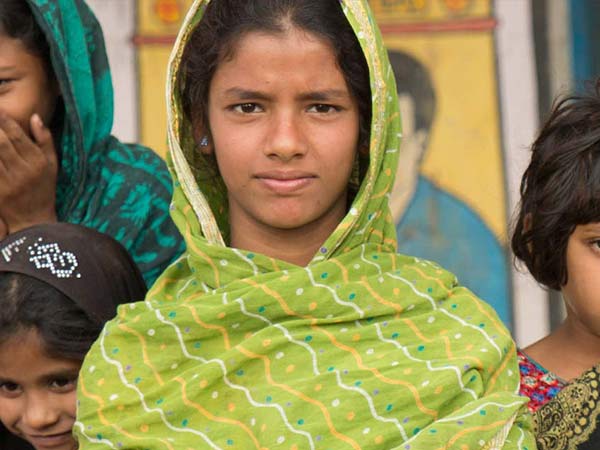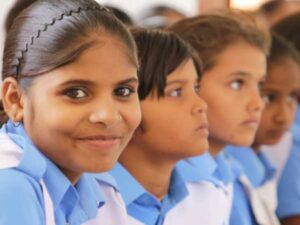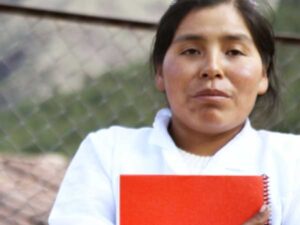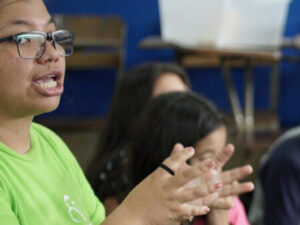Breakthrough works to make violence and discrimination against women and girls unacceptable. They shift cultural narratives within communities and the education system as well as develop leadership capacity among adolescents, youth, and their communities.
Mallika Dutt of Hewlett Foundation and Breakthrough spoke with Jessica Kantor on June 20, 2024. Click here to read the full conversation with insights highlighted.
Jessica Kantor: Can you introduce yourself, your organization, and the issue that you’re addressing with your work?
Mallika Dutt: While I work with the Hewlett Foundation, I’m here today to talk about my work as founder of an organization called Breakthrough, that has been looking at how to promote gender equity through culture change in India, in the United States, and in partnerships with groups around the world. We’re just celebrating our 25th anniversary.
Jessica Kantor: Fantastic. Are you a direct service organization?
Mallika Dutt: No, we are not a direct service organization. We are all about systems change, so the focus is on building out the ecosystems of actors that are necessary to move issues that lead to inequality and discrimination like early marriage, domestic violence, access to education for girls, and changing the norms for boys and girls. We’re currently doing that through education systems.
Jessica Kantor: How exactly are you engaging with the education systems and working towards systems change?
Mallika Dutt: We began with looking at how to shift narratives, how to shift ideas about gender and partnership within the entertainment industry, and how to bring new notions of how boys and girls, men and women, show up in the world through music albums, music videos, video games, and social media. We believe that storytelling, and the ways in which narratives get constructed, have a huge impact on how we interact with one another, on how we treat one another, and on the social structures we create and live in. Everything that we create is culture, and how we use culture to transform culture is the question that Breakthrough has asked since its inception.
When we started to work with the entertainment industry, we had an enormous amount of success. We created a music album and a music video that told the story of a woman who leaves a domestic violence situation and becomes a truck driver. It was the first time many people visually saw a woman driving a truck in the Indian landscape. The video wasn’t just about women driving trucks; it was about women’s participation in public spaces, women’s access to occupations, and women’s mobility. The storyline featured many women on the back of the truck coming together and celebrating solidarity and liberation, and presented the truck driver as a former battered woman who finds her way to this occupation. I’m sharing this with you in some detail because we forget the power of representation, and we also forget the power of representation that isn’t simply about showing what the current problem is, but the power of representation that also encompasses the vision of the world that we want to be inhabiting and participating in.
After that, we started to work in schools with curriculum, and with helping school teachers bring multimedia tools into conversations about gender and around issues of violence and discrimination. Over the years, our work evolved, and we realized that in order to achieve change, the narrative piece had to connect with a multiplicity of other actors in the ecosystem, so we needed not just to be working with schools and teachers, we needed to be working with parents. We needed to be working with community leaders. We needed, of course, to be working with the students themselves. As we grew, the work then evolved into thinking about systems change through education structures and curricula.
In India, the vast majority of schools are public schools that are government schools, and millions and millions of children are enrolled in these schools. Breakthrough now has Memorandums of Understanding [MOUs] with multiple state governments, through which we are actually working with the government and the education system to look at curriculum, and to assess how we can transform the curriculum so that existing language representation through which people learn about gender begin to evolve. How can we work with students in that system, how can we train teachers in that system, and how do we surround all of that with the entertainment industry narrative work and include the participation of parents and community leaders? All of that is needed to create the world that we desire.
Jessica Kantor: Do you think working directly with all of those agents, and having the backing of local government, is what makes your work distinctive?
Mallika Dutt: I think that a lot of us, particularly in the non-profit civil society space, have tended to look at issues very much in silos, or to attend to very specific aspects of a problem. As we started to do our formative research and really understand the relationship of all these different actors to one another, what we began to realize is that a lot of groups will focus on leadership of young people, for example, which is really important, but then the expectation is that young people are going to be able to transform themselves and everything around them, and we end up putting a lot of responsibility on them without really understanding what they are facing within their homes.
It’s not just how do we give them the tools to deal with what is happening in their homes, but how do we create places for parents to come together so that they, too, are being enrolled in the transformation process. Young people spend a lot of their time in schools. How do we understand what is happening in the school space? How do we transform everybody in the ecosystem into change agents for gender equity, for new ways of being and doing that we want to see in the world? Certainly, the education system and the state governments are where millions and millions of young people are being engaged on a daily basis.
Jessica Kantor: How are you tracking success and outcomes?
Mallika Dutt: We’ve done that in a number of different ways. Over the years we’ve done randomized control tests where we’ve identified schools where Breakthrough was participating and intervening with our programs, and schools where we were not seeing changes in attitude or behavior, particularly among students, but also among teachers and all of the other players, including parents. It’s the huge impact we had that allowed us to go to state governments and say, “Look, this is what we’ve been able to do with an incredibly limited amount of resources, in these ways, and we’d love to partner with you to expand that and move beyond these 150 schools to all of the schools in the state system.” It’s really been our track record in the monitoring and evaluation work that we’ve done that has allowed us to show how we’re doing the work, what’s working, and also what’s not working.
I think it’s really important for us to reframe the tracking into a learning process. We track so that we can learn. We tend to talk about tracking as a way to show impact because that’s what we’re being measured for and evaluated against. We’ve really created a monster around monitoring and evaluation in the movement and the nonprofit space because we’re expected to deliver results with very limited resources vis-a-vis entities that have millions and billions of dollars. So how do we engage in these questions as a group of people with a sense of curiosity and inquiry, and learning and emergence, saying here’s the experimentation, here’s what we’re learning, here’s what’s working, and here’s what’s not working? Without this, it’s just asking what’s the impact that you’re having, how are you going to scale it, and how is that going to become a model for replication? I find that an extremely limited way of understanding the very delicate and important work of culture and change and transformation that we’re all attempting to do.
Jessica Kantor: It’s interesting you say that because it’s something we’re hearing from quite a few people, along with the idea of outputs versus outcomes. So you are providing X number of things, food or access to water or something like that, but how is that actually impacting people? Is it pulling them out of poverty? Is it bringing them to the resources they need to move them out of that kind of social welfare system?
Mallika Dutt: The whole framing of that conversation is prosecutorial and penalizing rather than supporting and collaborative. We are having to do all of these things because our existing corporate and government systems have not succeeded in doing them. We are doing this work because we believe that another world is possible. We believe that something better, something that encompasses the well-being of all people, is possible. But instead of engaging in that conversation from a place of love, support, and curiosity, we attend to it with, “Well, how do you prove what you’re doing? What’s the impact that you’re having, outputs versus outcomes?”
I am quite astonished by the ways in which organizations that are doing really difficult work, in very difficult circumstances, are treated, while the current structures that are making billions and billions of dollars and creating the poverty and inequalities that lead to people not having access to water are not the ones being interrogated. They don’t have that same level of accountability. While Breakthrough has done incredible work, and I’m really proud of everything that we have accomplished, I also want to make sure that, in our solutions orientation and insight seeking, we do not replicate and continue to enforce this very prosecutorial way of asking questions and engaging with very delicate, very powerful, and very challenging work.
Jessica Kantor: Would you say that’s one of the main challenges that not only you but others in the space are facing?
Mallika Dutt: There are a number of challenges. There’s always the challenge of capital. When one thinks about business and the corporate world, and entrepreneurs trying to build a business for profit, there are multiple mechanisms through which capital can be accessed, at least for people with privilege in those systems. I’m not trying to deny that women and people of color trying to create businesses still have a lot of challenges, even within those worlds. But they have access to resources in ways that the philanthropy model and the social impact capital model do not. The ability of folks to raise the resources to do the very big work they’re trying to do is limited, and then they’re constantly being asked all these challenging questions around something that’s always a challenge, and that is difficult. If you want the outcomes and the impact that you want, you’ve got to come up with the capital to resources you need to provide the results that you want. It’s a simple thing. Instead of constantly expecting people to be heroic in doing that work, I think we should be looking at the capital resource question; it is absolutely critical.
We’re also dealing with a growing backlash against the enormous success we’ve been having. The changes we are making and witnessing in the gender equity space certainly are enormous: changes in the understandings of gender, in the roles of boys and girls and men and women, and the expansion of understanding how gender framing impacts lesbian, gay, and LGBTQI communities. There have been huge changes as a result of the work we’ve been doing, and it is upsetting people who have historically held power. There’s a backlash, and we are now dealing with those who propound patriarchal values or family values, and who want to adhere to old ways of thinking about the role of the family, or the role of women in the family, or the role of reproduction. In general, their resources are much, much larger than ours, so people are seeing pushback, repression, violence, and threats. We’re watching that happen right here in the United States, for example, around the question of reproductive equity.
It’s a reminder that this work comes with a great amount of personal, physical, community and collective risk. While we’re asking these larger questions about impact, how are we attending to the care, protection and well-being of people who are engaged in this work? Of course, when there’s transformation and change, there’s going to be backlash, but how might we be more creative about addressing it? How do we have those kinds of conversations? There are governments that are becoming more authoritarian and more repressive. In many countries, including in India, the space for civil society is starting to shrink.
There are many more regulations, outright intimidation, and even outright arresting of people who are on the front lines of this work. Again, the ability to move resources to those people and provide them with the safety and security that they need to do the work is emerging as a question. So, yes, solutions. And then as change happens, there are all of these ripple effects that have amazing transformative consequences for us as a community and as the world, and where we have to continue engaging with the aspects and forces of our cultures that don’t want that change to happen.
Jessica Kantor: Every social innovator learns as much from things that don’t work as things that do. Is there anything you can think of either recently, or maybe early on in the founding, that you tried but that didn’t work and taught you a lesson instead?
Mallika Dutt: Hundreds and hundreds of things. One is always iterating and exploring. Before I talk about what we’ve learned about from our own tracking, and what’s worked and what hasn’t worked, I want to again do a little bit of a reframe. Our current systems and structures– social, economic, political, educational– are not working. We are in a giant global crisis to the extent that the very earth on which all of this happens is in crisis. When we come to asking organizations or leaders or movements to share learnings about what’s working and what’s not working, let’s first acknowledge and understand that many of the systems that we are operating within are not working. They’re collapsing, and it is because they don’t work that our work exists in the first place.
Having said that, I find that one of the things that I have come to understand through my work at Breakthrough is the importance of creating a vision where everyone feels like they can participate in building the future. We are creating something that has much greater ability to bring naysayers along than when we create an us versus them situation.
Let me give you an example. We did a lot of work around women and HIV/AIDS for some years. We had partnerships with advertising agencies in India, and we created two multimedia campaigns. The first one was about asking men to wear condoms with their partners because the largest number of women in India with HIV were actually spouses. The second thing that was happening to women with HIV was they were then being thrown out of their homes. The first campaign looked at men wearing condoms with their wives, and it was called, What Kind of Man Are You? The second one was focused on the injustice of women losing their homes or becoming homeless, and it was called, Is this Justice? There were both big campaigns. We reached millions of people. We created a lot of discussion, a lot of awareness.
Then the women that we were working with came to us and said, “Look, this is all well and good, but our ability to negotiate safe sex within our marriages is pretty much non-existent. None of our work was speaking to what men needed to do with other men to shift these conversations. The third campaign we then did was called Ring the Bell. In that one, instead of pointing the finger at men, we invited men to be part of shifting the norm. So you’re a neighbor, you hear a violent altercation. Down the corridor, you hear a man beating his wife while you are drinking your tea. What do you do? You get up, you go ring the bell, and you ask for sugar or something to interrupt the cycle.
In that moment, as one man is looking at the other man, it’s very clear that there’s a message being communicated that, “This is not okay. This is not acceptable behavior.” The Ring the Bell campaign went completely through the charts. It became a huge social movement. It ended up becoming episodes on soap operas. It ended up becoming a question on Who Wants To Be A Millionaire? in India, and it just had a resonance that taught us a lot about what happens when we enrolled men and engaged men. It wasn’t that we weren’t lifting up the problem; they were still dealing with domestic violence. But when we enrolled men as part of the journey and part of the movement, it had a very different resonance than when we said, “You are the problem” and left it there. We learned many lessons along the way around the role of government officials, the role of local elected officials, and the role of parents, especially fathers.
We discovered that in our work around early marriage, enrolling fathers to be advocates for their girls to finish school was actually more catalytic than engaging mothers. Now, of course, when you think back, you’re like, “Well, of course, they’re the ones with more power in the family.” There were lots of assumptions that we made that were continually challenged by the work itself and how things evolved. I would say my biggest lesson from my work at Breakthrough has been learning how to engage and enroll everyone towards a collective vision while raising the challenges and issues that we need to fix and change.
Jessica Kantor: Thank you for sharing that. You mentioned earlier that in your work in schools, simply replicating and scaling doesn’t necessarily fit because you need to get into the community to build relationships and acknowledge cultural sensitivities. How are you doing that in a way that allows you to work closely with leadership, and that makes replicating that model in other schools a little easier?
Mallika Dutt: Something I have come to support is releasing the word “model” when describing this work and instead, using and uplifting the word “approach.” When you think about models, they have a formula, and they have a self-contained logic to them. What we try to do is say, “Okay, here’s the model, and now we’re going to imprint this in a multiplicity of places.” When you think about an approach, you consider: Where are the elements of that approach? What are some of the principles? What are some of the building blocks? When you bring an approach from everything that you’ve learned to a situation, but it isn’t the closed loop of a model system, you’re able to be much more responsive and creative with the communities you’re working with.
For example, in India, we have a caste system. There are communities that come from different castes, particularly in rural areas. Those caste identities make a big difference in terms of resources, access to resources, schools, and how government teachers even respond to those folks. For us to just assume that a model is going to then work for every one of those communities, well, it doesn’t really work like that. We may be starting by simply figuring out how children from multiple castes are sitting in the same classroom, or how water is being accessed in a classroom, because access to food and water is also determined by caste identity. How are we going to have the parents of all the kids in the classroom, who come from multiple caste backgrounds, come to the same meeting, come to the same events? Then, what happens when you add the layer of religion? We’ve seen an increasing schism between Muslim and Hindu communities in India recently.
I’m using that as an example of how, when you walk into a situation, you really have to be fully in it. You have to be sensitive to and aware of all of these different dynamics that are at play, that are going to make whatever it is that you’re doing successful or not, because that’s the clay that you’re working with. It changes, again, depending on who the education minister is, which party is in power, who’s the secretary. Here, the secretary is the highest-ranking bureaucrat in the state system, the person who is responsible for making this happen. Does that person have the appetite to really push, really make change, or do they have to be brought along?
What happens when an election occurs, and the party changes, but you’ve got the MOU? How do you deal with a whole new group of people? I really believe that the key to achieving scale is developing something that can spread and be incorporated [in different ways in different places], something that is adaptive and emergent. It’s not, “Here’s a model and now we’re going to impose this every place that we go and expect to have the same results that we had in the state of Haryana in the state of Punjab or in the state of Orissa.” They speak different languages for God’s sake. I believe that there’s some reframing that’s important for us to be doing in terms of how we think about this work. I’ve eliminated the word model from my vocabulary.
Jessica Kantor: Is there anything else that you feel is important to add?
Mallika Dutt: I would reiterate the need for us to bring more care into this work– how we think about it, how we do it, how we talk about it– and remember just how difficult it is. To consider what is needed to support our own engagement and ensure that we don’t burn out. To invite everybody who does this work, especially leaders within organizations, to think about the needs and the value of care for employees in the same ways that we think about the folks to whom we are in service, with deep love and appreciation for what we’re trying to transform.
It’s also essential for us to think about bringing that same energy of love and transformation to our institutions and our communities and each other. And then to invite those who fund this work, who come either from philanthropy or the impact world, to infuse care and the idea of the wellbeing of everybody in this ecosystem as both practice and outcome. At the end of the day, what are we all trying to do? We are trying to create a world where the wellbeing of everybody, and this planet, is center stage. That’s what we’re all trying to do ultimately, so let’s not just think about that as the external goal, but also as the practice that we need to welcome ourselves into.
Jessica Kantor: Wonderful. Thank you so much for your time.
Click here to read the full conversation with insights highlighted.
Jessica Kantor is an independent journalist specializing in health, human rights, and social impact. Her work can be found in Fast Company, Healthcare Quarterly, The Las Vegas Review-Journal, and others. She is a living kidney donor.
* This interview has been edited and condensed.
Read about other social innovations in women’s rights.







